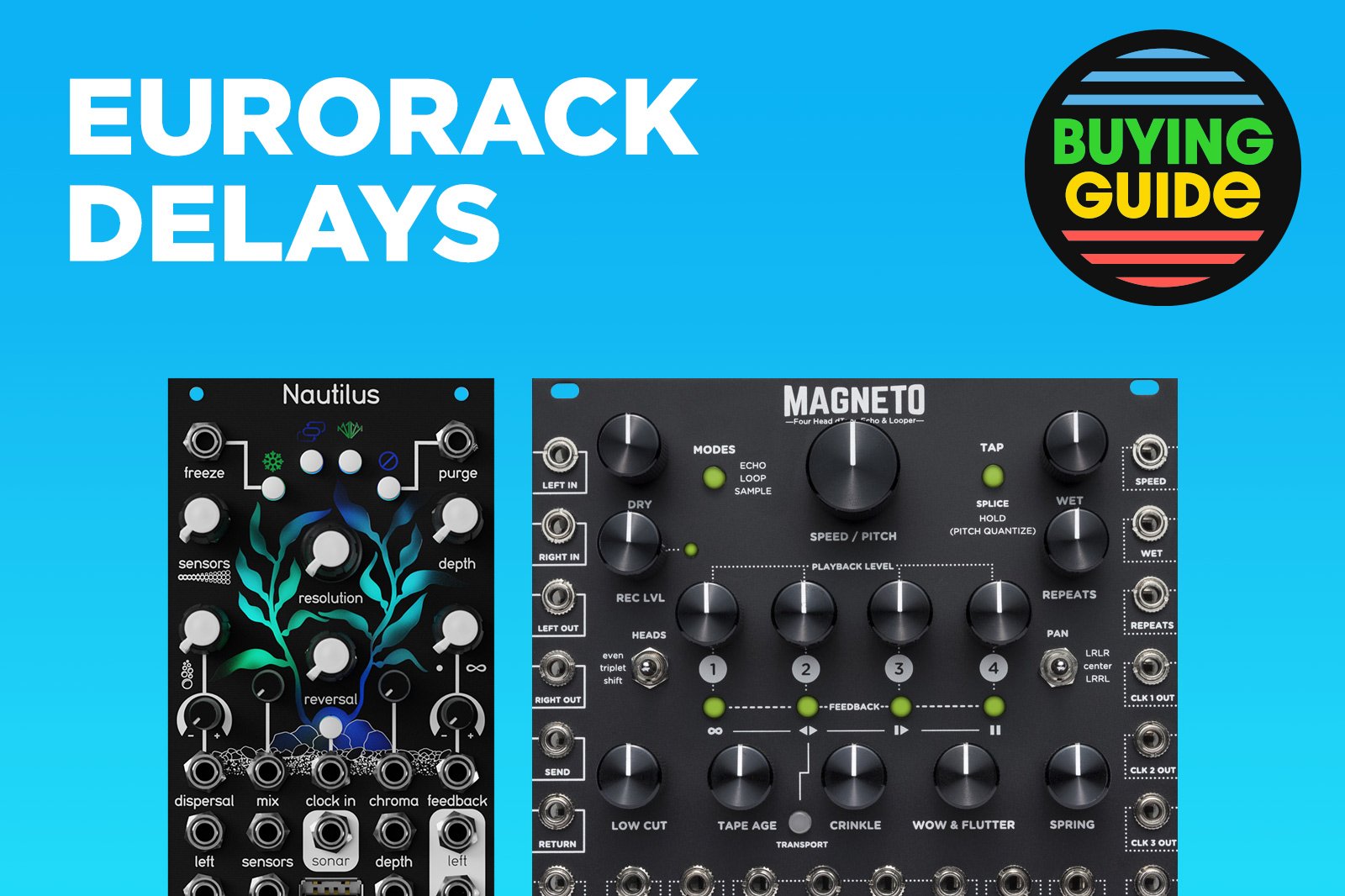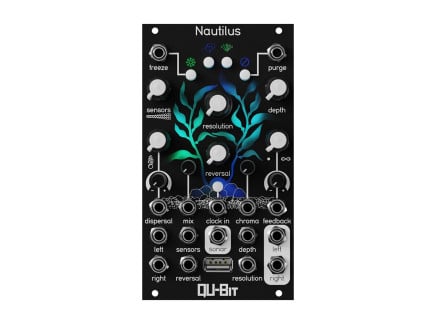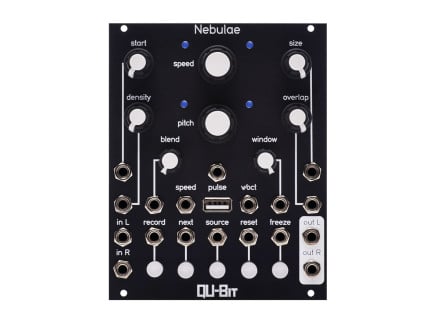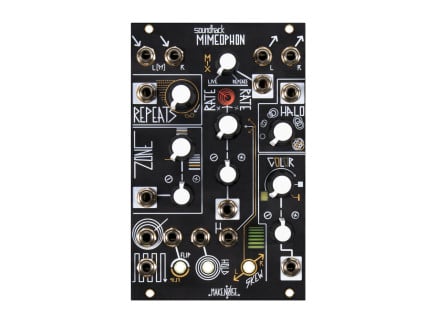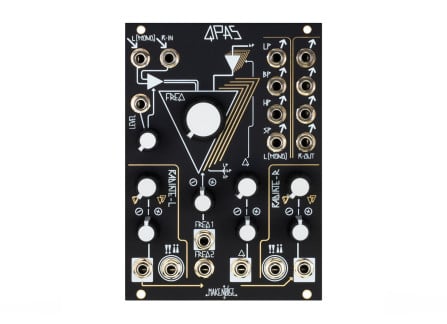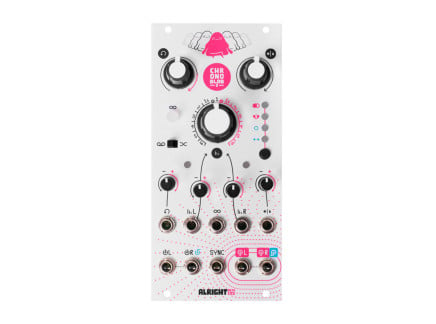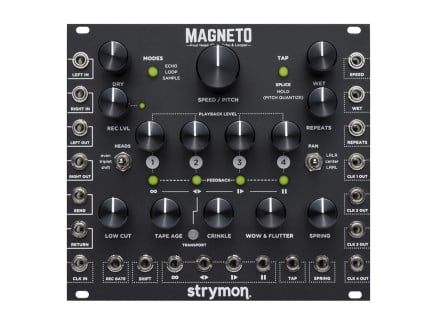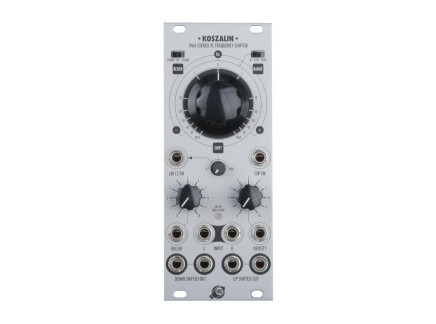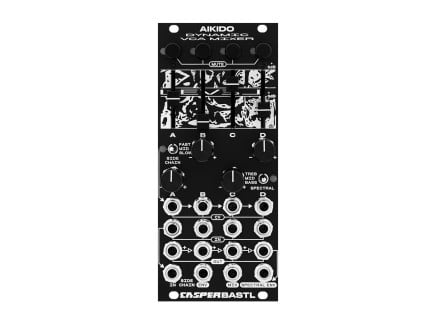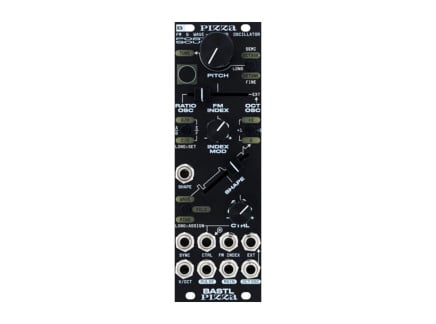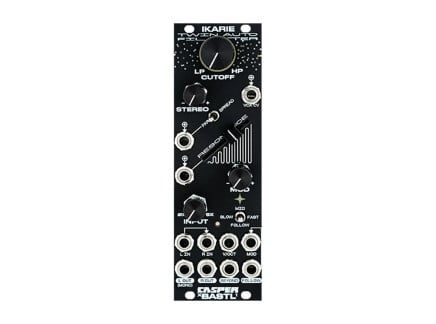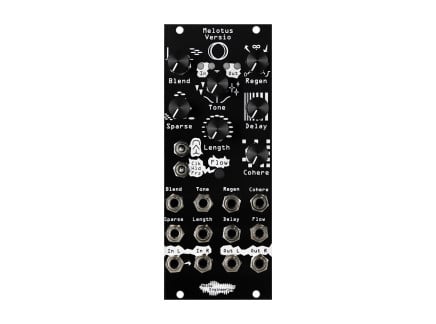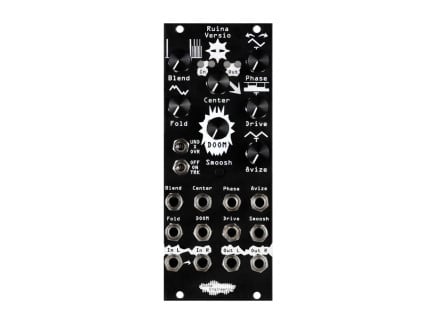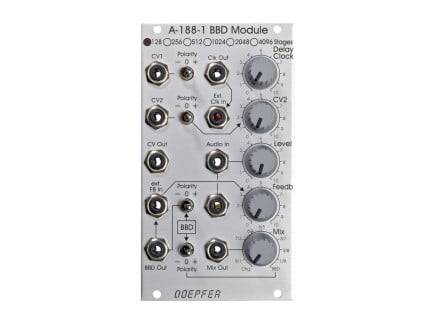In the world of audio mixing, delays might be the last in the chain for nuanced flavoring of audio material. But in the world of modular synthesis, they are often compositional tools in their own right. Modern delay circuits give you a lot of functionality for tone shaping, feedback patching, and stereo imaging, without taking up too much space.
In this buying guide, we have rounded up some of our favorite Eurorack delay modules out there. The list features classic bucket brigade delays, digital delays with saturation and distortion, and the ever-pleasing tape-head delays for that old-school warmth. If your modular rack is missing a delay, treat this list as a starting point for finding the right thing for you.
Qu-Bit Nautilus
Nautilus from Qu-Bit is a complex delay with eight delay lines that can be connected in interesting ways. You can control the number of active delay lines with Sensors and adjust the spacing between them with Dispersal. Manipulating the spacing between the active delay lines creates polyrhythms, guitar-like strums, or chaos that can come in handy for transitions during a live performance. And—you can do all of that with a single clock source.
Nautilus also allows you to shape your delays with its six built-in effects. There is a lowpass and a highpass filter for tonal shaping, and there are four different ways of adding saturation to your delay lines, including a wavefolding option.
Playing around with the internal or external clock rate modulates the delay lines, based on the mode you are in. There is the classic Doppler mode for pitch-shifting effect, Fade for seamlessly transitioning between different delay times, and Shimmer and De-Shimmer, which add a pitch-shifted delay relative to the input signal.
You can even use Nautilus as a beat repeat machine. Hold Freeze to lock the delay buffer and then play around with the Resolution knob, which acts as a multiplier or divider for an incoming clock. There are 4 feedback modes to choose from, and a handy CV output with Sonar, which can even give you a variable clock output when you are CV controlling the Resolution.
From classic delay patches to experimental rhythmic results and chaotic sonic territory, Nautilus is a modern Eurorack delay that can do a lot.
Key features:
- Stereo delay with eight delay lines
- External clock sync
- Freeze function to hold the delay buffer
- Six built-in effects including high-pass filter, low-pass filter, saturation, and distortion
- Four delay modes
- Up to 80-second delays
- Four feedback modes
- Sonar for CV generation, including complex waveshapes
- Great for: Creating polyrhythms from delays, beat repeat function, and performing live, given its hands-on UI. There is hardly any menu-diving, despite the versatile functionality.
Make Noise Mimeophon
Speaking of versatile delays, there is Make Noise Mimeophon. The stereo delay has eight delay "zones" that you can switch between, either manually or with CV. These "zones" occupy different time ranges, allowing you to create all sorts of delay effects, from your classic echo effects to Karplus-Strong synthesis, phasing and stuttering, and looped phrases that are perfect for experimental ambient performances. Switching between the zones is free of Doppler effect, so there are no pitch changes in your delays.
But if you want that classic delay function, there is the dedicated micro-rate control for controlling your Doppler modulation. Mimeophon has an internal clock and an external clock sync, too. When externally clocked, the Rate control acts as a multiplier or divider for delay repeats, allowing you to create surprising rhythmic patterns. Speaking of repeats, you can go all the way up to infinity for those washed-out, chaotic patches. Use Halo to spread the repeats in stereo space for added dimension and use Color for timbral changes to your delay line over time.
You can even control the repeats on the left and right channels differently with the Skew knob. When Skew is engaged, the repeats of the left and right channels go in opposite directions. Increasing repeats on the left will cause the repeats to decrease on the right and vice-versa.
Much like the Freeze function in Nautilus, Mimeophon has a Hold button for freezing the delay buffer. You can also engage Hold with a gate input. Imagine supplying a slow clock to the Hold function so Morphagene switches between frozen delay buffers and classic repeats.
Key features:
- Stereo delay with input normalization to the left channel
- Morph between eight different Zones for different time-based effects: delay, looping, flanging, comb filtering, and more
- Hold function for freezing the delay buffer
- External clock input
- Repeats upto infinity
- Dedicated control for Doppler effect
- Stereo shaping options with Halo
- Rate Out for pulse generation at skewed tempos
- Great for: Stereo delays with surprising rhythmic patterns, ambient FX-heavy performances with looped phrases, supplying an irregular clock to other parts of your rack
Verbos Multi-Delay Processor
Inspired by Buchla’s never-quite-completed 288 Time Domain Processor, Verbos Multi-Delay Processor is a digital multi-tap delay with eight delay lines connected in series. You can control the level of each delay individually with handy faders. The overall delay time of the module can be set with a big knob on the bottom right. You can also control the delay time with two CV inputs, both of which have dedicated attenuverters.
Where the Verbos Multi-Delay really shines is feedback patching. Each delay tap has its own individual output, which can be patched back into one of the three available inputs. You can also patch the entire mix out to one of the inputs for some surprising multi-tap delay effects. Here, too, you have options. You can take one of the preset mixes or take the manual mix out for feedback patching.
Inputs 2 and 3 of Verbos Multi Delay allow you to create dense reverbs and shimmers, thanks to normalled internal octave shifting and reverb effects following the eighth tap output. Each delay also has a dedicated envelope follower output, which you can use to modulate other parts of your rack. Or, the envelope follower outputs can be fed into a mixer and then fed back into one of the inputs on the Multi Delay for complex modulation. Despite (seemingly) fewer controls compared to a Morphagene or a Nautilus, Verbos Multi Delay has plenty of options for creative delay patching.
Key features:
- Eight digital delays in series
- Individual volume fader, output, and envelope follower output for each delay
- Preset mix outs
- Three-input mixer for feedback patching
- Self-oscillation at high feedback values
- Two CV inputs for delay time modulation
- Shimmers and dense reverbs with octave shifting
- Great for: Feedback patching, multi-tap delays, and CV outs for other parts of your rack
Alright Devices Chronoblob 2
Chronoblob 2 is the successor to the ever-popular Chronoblob. It retains a lot of the functions of the first one while adding stereo functionality to it. There are four delay modes you can choose from—dual, ping-pong, single, and cascade. In Single mode, the right channels of input and output can be used for sends and returns. So, you can patch in another effect and use it to process the delay circuit's feedback path, for evolving repeats. Experiment with a wavefolder or even a low-pass filter for surprising results.
There is external clock sync, and CV inputs for time modulation, feedback, and dry/wet signals. Each of them have their dedicated attenuators so you can really dial-in your delay effect. Other than giving you a lot of control over your delays, it also makes Chronoblob 2 very performance-friendly. Like its predecessor, you can switch between smooth fades and tape-style time modulation with a simple switch.
You can also lock the feedback at 100% with the infinity switch or gate it for rhythmic results.
Key features:
- Stereo delay with stereo input and output
- External clock sync
- Four delay modes
- Two time modulation styles—tape-style pitch shifting and smooth fades
- Two CV controls for delay times
- Left and right channels can be independently controlled in dual and ping-pong modes
- Send and Return patching in Single and Cascade modes
- Infinity button for locking the feedback at 100%
- Great for: Clean, clock-synced delays, live performances
Strymon Magneto
Strymon is revered for its pedals, but Magneto was their first foray into the world of Eurorack—and quite a successful one, at that. Magneto is a multi-head tape delay that can also function as a looper, a phrase sampler, and a lush reverb. Almost every functionality has its own dedicated controls, which makes this delay module very playable in live settings.
You can control the level, feedback, and panning of each of the four play heads. And each head has its own dedicated clock output, which means you can use Magneto as a clock multiplier, too. You can even control the spacing between the play heads with a handy switch that toggles between even, triplets, and Shift. The Shift mode is for pitch-shifted delays at intervals of octaves or fifths apart.
There is plenty of control to shape our delays, too. Crank up the record level for some warm tape saturation. There is Low Cut for a brighter response and three different flavors of tape imperfections. Dial up Crinkle at low delay times for some really wonky results.
There are transport controls for reversing or pausing the tape heads, which are available in all the three modes. Transport controls are great for getting those tape-stop effects and varispeed delay. You can also quantize the pitch of your delays and select between 15 built-in scales. However, the visual feedback for the scales is not entirely intuitive—you may want to keep a user manual around.
Despite its (relatively) large footprint, Magneto offers a good function:form ratio with a UI that is very performance friendly. And it sounds excellent.
Key features:
- Multi-head tape-style delay
- Choose between Echo, Looper, and Phrase Sampler modes
- Built-in spring reverb with level control
- Tape saturation when input level is cranked up
- Four delay shaping options with the Tape Mechanics section
- Individual level, feedback and panning controls for the 4 play heads
- Individual clock outs for the play heads, which makes it useful as a clock multiplier
- Pitch quantisation
- Self oscillation, which means you can use it as a tone generator
- Varispeed tape delay effect
- Great for: Versatile delay patching, classic tape delay effects, tape saturation, and live playability
Xaoc Devices Sarajewo
Featuring three Bucket Brigade Delay (BBD) chips, the Xaoc Devices Sarajewo is a multi-tap analog delay. Bandpass and lowpass filtering at the input and output respectively ensure a clean delay signal with minimal artifacts. In terms of functions, there is external clock sync, a built-in tilt filter and sliders for shaping the tone of the delay, and an input for external feedback loop—loads of features for an analog delay in any format.
The external feedback loop comes in handy when using Sarajewo for short delay times. You can patch the first delay tap output, for example, into the external feedback loop for expected delay behavior when the delay time for the third tap is short. In terms of outputs, there are individual outputs for all the three delays. You could take the three simultaneous outputs into a mixer and have fun with it. There is also a continuous mix output, which is a mix of the input signal and the third delay output.
Key features:
- Analog 3-tap delay
- Built-in tilt filter for tone shaping
- Free mode and clock syncable via Tap tempo and external clock input
- Anti-aliasing and anti-imaging filters for a clean signal
- Individual outputs for the three tap delays
- A continuous mix output
- CV controllable time divisions
- Great for: Long delay times, self-patching techniques, and feedback loops
Bastl Instruments Basil
Despite its compact size, Bastl's Basil goes beyond a typical delay module. The digital delay allows you to create a host of classic delay effects, including chorus, flanger, pitch-shifting delays, vibrato, and reverb.
The feedback circuit of Basil features a filter, a fine-tune knob for delay, and a V/oct input, which means Karplus-Strong synthesis on this is a breeze. There is multi-tap delay with variable spacing, a Blur function to diffuse the delay in stereo space, and an assignable control knob that allows you to map incoming CV to any of the parameters.
You can even use Basil for designing tasty drones. Use the Speed function to run the delay buffer at half speed and build lurking drones as you change the speed of the buffer. An anti-aliasing filter at the output prevents high-frequency artifacts at low buffer speeds. But the Lofi button switches off this filter if you want to go for that lo-fi goodness. Also worth noting—Bastl's Pizza complex oscillator uses the same hardware as Basil, and the firmware can be swapped by the user at will...so you're getting multiple modules in one!
Key features:
- Digital stereo delay
- External clock sync
- Ping-pong and simple feedback modes
- Built-in filter for tone shaping
- 1V/oct tracking for Karplus-Strong synthesis
- Blur for diffusing delays
- Freeze to hold delay buffers for looping
- Lo-fi mode for turning off the anti-aliasing filter
- Great for: Creating ambient washes, distorted drone layers, and glitchy delays
Noise Engineering Imitor Versio
If you are after a delay module that can dance wildly in the stereo field, Noise Engineering Imitor Versio is your answer. It is a 12-tap delay. Unlike the Verbos Multi-Delay, though, you cannot control the individual levels of the delay lines. You get a minimum of 12 repeats every time you fire this module.
But there is enough control for shaping these 12 repeats. Turn the feedback amount high enough with Regen and you get sidechain-like effects. The speed control with Skew changes the spacing between the 12 delay lines. In the center, the lines are equally spaced. On the left or the right, the spacing gets slower or faster. So, you can create classic modular synthesis patches, such as the bouncing-ball effect by moving around the Skew knob.
There are three delay modes to choose from, including shimmer for those ambient drones. You can also create crescendo or decrescendo delays with the toggle button below the delay modes. And then there is Angle that spreads the delays in the stereo field. At extreme values, you get delays that are wildly dancing in the stereo field. There is Tap tempo and an external clock input for syncing your delay times to a master clock in your rack. And of course, since the hardware platform is shared between all of Noise Engineering's Versio modules, you can always swap the firmware to turn your Imitor Versio into a complex reverb, auto-wah, stereo distortion, and much more!
Key features:
- 12-tap multimode delay
- Tap tempo and external clock sync
- Three delay modes, including a pitch-shifted shimmer
- Add crescendos or decrescendos to your delay lines
- Modulate the spacing between the 12 delay lines manually or with CV
- Modulate the stereo imaging of the delays with Angle
- Great for: Creating width from mono sound sources, evolving stereo imaging, classic synth patches such as the bouncing ball effect
Doepfer A-188-1 Analog Delay
For classic analog delay in your modular rack, Doepfer A-188-1 is a worthy contender. The bucket brigade delay has two CV inputs for modulating the delay times. One of the CV inputs has an attenuator for more control. You can sync it to an external clock as well—though it should be noted that this is for the direct BBD clock, and not necessarily for rhythmic syncing effects: it's about controlling the delay's overall sample rate. At low clock rates, this can be a quite peculiar and destructive effect.
There is an external feedback loop input for feedback patching. In fact, the A-188-1 can easily get into self-oscillation territory. There is an individual output for the delays and a continuous mix out, in addition to a CV out that can be used elsewhere in your rack. Offering limited functionality when compared to more modern delay modules, the Doepfer A-188-1 can be a reliable workhorse delay in your modular rack.
It's worth noting that A-188-1 is available in multiple flavors, based on the number of BBD stages it provides—A-188-1X being the shortest, ad only 128 stages, and A-188-1D being the longest, at 4096 stages. Shorter numbers of stages work better for flanging/comb filtering/etc., while longer times will give you more conventional delay-like effects.
Key features:
- Analog Bucket Brigade Delay
- Two CV controls for modulating the delay time
- CV out for self-patching or additional modulation in your rack
- External clock sync and a clock out
- Separate delay out and mix outs
- Great for: Classic repeats, Karplus-Strong synthesis, chorus, and flanger
Our Takeaways
When choosing a delay module for your rack, consider the kind of tonality you are after, the amount of playability you want, and the degree of surprises you are comfortable with. For example, if you are looking for expected results, go for something like a Doepfer A-188-1 or a Verbos Multi Delay. For more creative sound design possibilities, the Qu-Bit Nautilus or the Bastl Basil are great options. If you are after a dynamic stereo field, the Make Noise Mimeophon or the Noise Engineering Imitor Versio are good bets.
Similarly, if you are primarily looking at a delay that can be tweaked live, go for something that has minimal menu-diving, such as the Strymon Magneto or the Alright Chronoblob 2. And of course, the kind of music you primarily make counts, too. For drones and layering, the Bastl Basil can get you into unexpected territories, and so can Nautilus.
Even if you aren’t completely sure about which one to pick, you can’t go wrong with these. These are some of the best delay modules for Eurorack and are being used by some of the best modular synth artists out there. And if you're still looking for more, don't worry: you can check out our full selection of Eurorack delay modules to get started on your modular delay journey.

